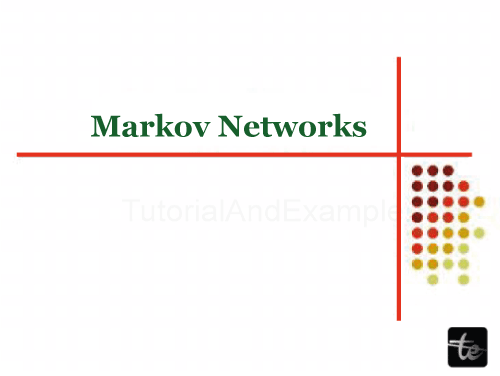Markov Network in Artificial Intelligence
Introduction:

A Markov network is an undirected graphical model made up of nodes (which represent random variables) and edges that connect these nodes. In contrast to directed graphical models (such as Bayesian networks), Markov networks lack arrows that indicate the direction of effect between variables. Instead, they represent conditional dependencies between variables using cliques and potentials. Markov networks are also known as Markov random fields (MRF) and are visual representations of probabilistic reasoning used in artificial intelligence and machine learning. They are named after the Russian mathematician Andrey Markov and are used in computer vision, natural language processing, bioinformatics (BI), and other areas.
Working of Markov Network
Markov networks work as follows:
- Nodes: Each node in the graph represents a discrete or continuous random variable. In an image processing application, for example, nodes may represent the pixels in a picture.
- Potentials: Associated with each clique, there is a potential function that quantifies the relationship between the variables within the clique. The potential function assigns a numerical value to each combination of variable assignments in the clique.
- Cliques: A clique is a fully connected subset of nodes in the graph. In other words, every node in a clique is linked to every other node in that clique. The presence of cliques captures the concept of conditional dependencies among variables.
- Factorization: The joint probability distribution of all the variables in the Markov network can be factorized as the product of all the potential functions in the cliques. This factorization allows efficient computation of probabilities in the network.
The fundamental idea behind Markov networks is the Markov property, which states that each node is conditionally independent of its non-descendants given its parents in the graph. This property allows for the compact representation of complex probability distributions with fewer parameters compared to explicit representations like tables.
Inference in Markov networks involves tasks such as computing the marginal probabilities of individual variables, finding the most probable configuration of variables given evidence (MAP inference), and computing expectations of functions over the variables.
Learning in Markov networks involves estimating the potential functions or learning the structure of the graph from data. Common learning approaches include maximum likelihood estimation, Bayesian methods, and techniques like the conditional random field (CRF) and maximum entropy Markov model (MEMM).
Overall, Markov networks provide a flexible and powerful framework for modeling complex probabilistic relationships among variables, making them valuable tools in artificial intelligence and machine learning tasks that involve uncertainty and dependencies.
Applications
Markov networks, also known as Markov random fields (MRFs), have a wide range of applications in artificial intelligence. They are particularly useful in tasks that involve uncertainty, dependencies, and probabilistic reasoning. Some of the key applications of Markov networks in AI include:
- Computer Vision: In computer vision, Markov networks are used for tasks like image segmentation, object recognition, and image denoising. They help model spatial relationships between pixels or image regions, allowing for more accurate and robust image analysis.
- Natural Language Processing (NLP): Markov networks find applications in NLP tasks such as part-of-speech tagging, named entity recognition, and machine translation. They can model the dependencies between words and their contextual information in sentences or documents.
- Speech Recognition: In speech recognition systems, Markov networks help model the temporal dependencies between phonemes, words, or linguistic units, improving the accuracy of speech-to-text conversion.
- Bioinformatics: Markov networks are used in bioinformatics to model protein-protein interactions, gene regulatory networks, and other biological processes. They help infer relationships between biomolecules and predict their functions.
- Recommender Systems: In recommender systems, Markov networks can model user-item interactions and preferences. They can be used to make personalized product recommendations based on historical user behavior.
- Social Network Analysis: Markov networks are employed to analyze social networks and model interactions between individuals or groups. They can help identify influential nodes, detect communities, and predict links in the network.
- Robotics: Markov networks play a role in robot localization and mapping problems, allowing robots to reason about their environment and plan actions under uncertainty.
- Anomaly Detection: In anomaly detection applications, Markov networks can model the normal behavior of a system and detect deviations from this norm, indicating potential anomalies or failures.
- Medical Diagnosis: Markov networks can be used for medical diagnosis and decision support systems. They help integrate patient symptoms, test results, and medical knowledge to provide probabilistic diagnoses.
- Game Playing: Markov networks have been applied in game-playing AI agents, such as poker-playing bots. They allow agents to reason about uncertain information and make optimal decisions in games with imperfect information.
These applications demonstrate the versatility and utility of Markov networks in tackling a wide range of real-world problems in artificial intelligence. By capturing probabilistic dependencies among variables, Markov networks enable more robust and accurate decision-making in complex and uncertain environments.